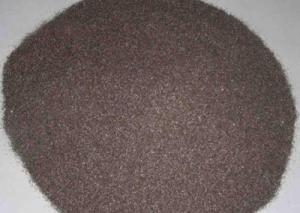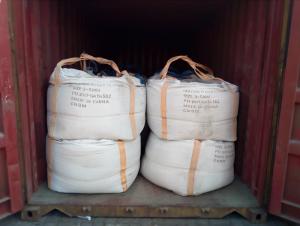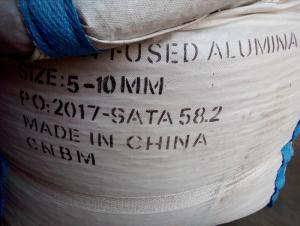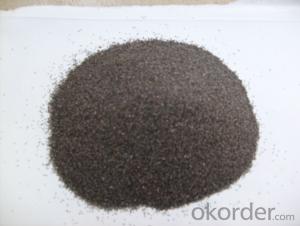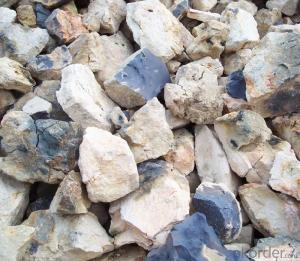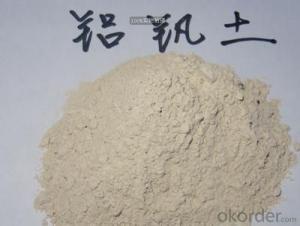TILTING BROWN FUSED ALUMINA IN GRAINS SIZES
- Loading Port:
- Tianjin
- Payment Terms:
- TT or LC
- Min Order Qty:
- 25 m.t.
- Supply Capability:
- 10000 m.t./month

- OKorder Service Pledge
- Quality Product
- Order Online Tracking
- Timely Delivery

- OKorder Financial Service
- Credit Rating
- Credit Services
- Credit Purchasing
Quick Details
· Place of Origin: Henan, China
· Shape: Block or grain size or powder
· Material: Alumina
· Al2O3:95%min
· SiO2:1.3%max
· TiO2: 3%max
· Fe2O3:0.3%max
· CAO:0.6%max
· MGO:0.3%max
· K2O+Na2O:0.3%max
· B.D:3.8g/cm3min
· MOI:0.2%max
· Refractoriness (Degree):1770°< Refractoriness< 2000°
· Model Number:Customer's Requirement
· Brand Name:CMAX
· Application:Metallurgy and Refractory
· Product name: Brown Fused Alumina
· Color: Brown
· Size:50MESH/100MESH/200MESH/325MESH/0-1MM/1-3MM/3-5MM/0-40MM
· BULK DENSITY:3.8g/cm3min
· Certificate:ISO9001
· Usage:Fire Resistance Place
· Type:Raw Refractory
· Packaging Details:Bags/In bulk/As costomer's requirement'
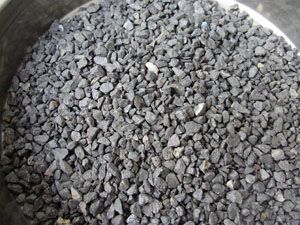
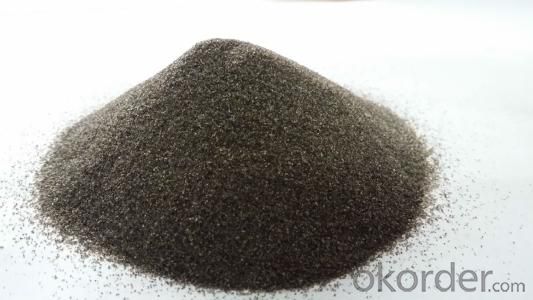
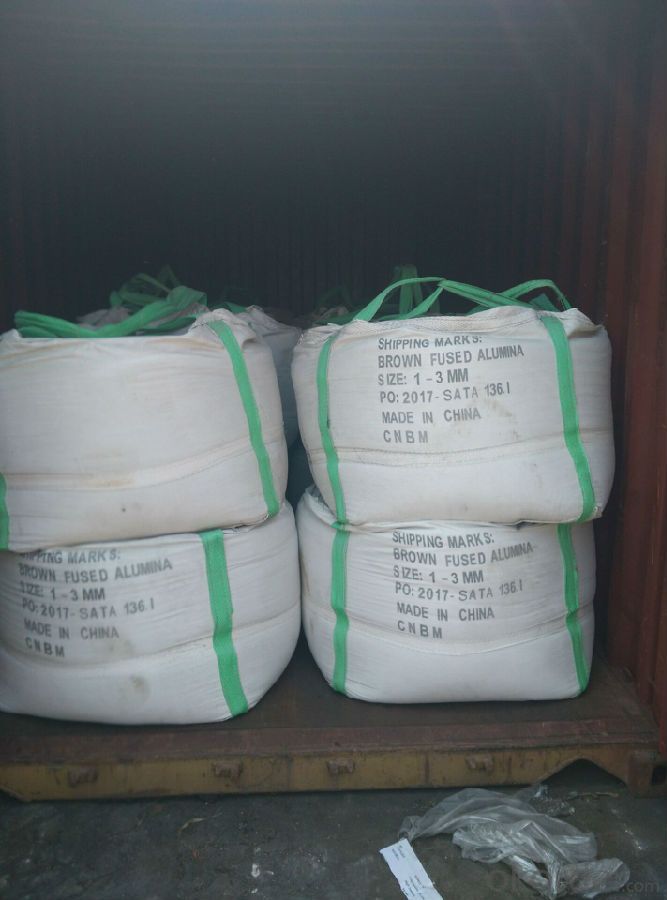
Quality assurance:
1.On a regular basis or as per your request,we entrust national testing agencies to conduct quality inspections
2. Strictly in accordance with the ISO9001-2008 international quality system standard,we monitor and manage the whole process throughout production,quality testing,and measurement to ensure product quality
FAQ:
Q: What kind of payments does your support?
A: T/T, L/C, Cash are accepted.
Q: Do you charge for the samples?
A: Accordeing to our company policy, the samples are free, you only charge the freight fee. And we will return the freight fee during the next order.
Q: Can you produce according to customers' design?
A: Sure, we are professional manufacturer.
Q: Do you have other products?
A: Yes, please check our other products in website.
- Q:What advantage and disadvantages it has compared to common fire insulation materials
- Main advantage of A-level fire proof heat retaining plate is A-level non-conbustibility. Now residential areas strictly require the external walls to be high-level fire proof, to be specific, high fire resistance, non combustible. Standards for evaluation varies according to different types, which includes anti-corrosion, acid and alkali resistance, waterproof, anti termites and so on. Disadvantage is the insulation effect is quite ordinary. It will absorb water, get deformed, need some water prevention measures after constrcuting thermal insulating layer for it. Its thermal conductivity far below the benzene plate, and plastic extruded palte, half the thickness of the polyurethane insulation layer can reach heat perservation effectiveness of the benzene plate and extruded plate of the same thickness.
- Q:Why does refractory need to add coarse firstly and then add fine aggregate?
- Binding agent can wrap particles and improve binding effect.
- Q:What are the differences of ceramics and refractories? Is the ceramics belonging to refractories?
- No In the high school chemistry, the former is talking about the traditional inorganic material, the latter is belonged to the new materials.
- Q:which kind of material is chosen for fireproofing window?
- (1) window frame uses steel frame or wooden frame with certain strength that can safeguard the integrity and stability of the components. (2) steel frame and mound layer can choose galvanized?steel?sheet or stainless steel plate. Its selection criteria conform to the article 5.1 in GB12955 Steel Fireproof Door General Technical Condition. (3) the selection criteria of wooden frame and mound layer should conform to the article 5.1 in GB12955 Wooden Fireproof Door General Technical Condition. (4) the inside filler material of steel, wood frame should use incombustible material. (5) fire-resistant glass can choose test approved products without affecting the fire resistance of fireproofing windows . Light transmittance of glass should not be less than 75% of same layers commom sheet glass. (6) the sealing material between the frame and the fire-resistant glass should use flame retardant materials, it can play a role of fireproofing and smoke insulation in the fire.
- Q:Does anyone know what is the use of waste refractory materials?
- 1.Waste refractory bricks can be reused to make the refractory bricks after being crushed by crusher, but the price is not very high. The purchasing price of refractory plant is ?60/ton. Because the refractory material has been calcinated for two times, it becomes easier to make bricks expansion coefficient with waste refractory bricks, but too much is inadvisable. If too much, the refractory materials would have a bad combination, which will give rise to loose bricks and incomplete corners. Nowadays, ordinary refractory plants would purchase waste refractory bricks to produce bricks, but better plants wouldn’t do this.
- Q:Who knows how many fire heat preservation material are there?
- They can be divided into wood fire, steel fire and stainless steel fire. Wooden fireproofing material is light weight, easy for installation and second decoration, as well as all types of civil construction and some industrial buildings. It can be realized through inorganic insulation materials, such as glass wool, rock wool, foam glass etc.. The phenolic foam materials inside organic foam material is more special. Phenolic foam does not only have a good thermal insulation performance, but also can be combined with steel and other materials, to achieve a class A fire retardant level. Class A thermal insulation include: 1 thermal insulation materials with class A combustion performance Fire insulation materials of fire barrier zone can use class A material with class A combustion performance in rock (ore) cotton, foam glass, inorganic thermal insulation mortar.
- Q:What are the commonly used admixture for alumina-magnesia refractory? What are the impacts on its performance?
- 2, form Mg-SiO2 coagulation and combination, CA cement bond? Bricks can generally be made by combing with phenolic resin, castable use 1, combined with silicon powder; 3, can also combined with brine MgCl is binding agent
- Q:How is the development of Xinmi refractories industry? What's its advantages and disadvantages?
- The disadvantage is too small yard, vicious competition among each other and confusion in the market, which should be the inferiority of national refractory industry . Xinmi Refractory is well developed in recent years, mostly acidic and neutral refractories. It is still relatively rare to use in iron parts, steel pile with a satin and other basic refractory slide .
- Q:Does refractory belong to metallurgical auxiliary materials?
- Refractory is widely used in industrial circle, such as metallurgy, chemical industry, petroleum, mechanical manufacturing, silicate and power, and its coonsumption is the maximum in metallurgy, accounting for 50% to 60% in total output. In order to improve slag-corrosion resistance of furnace lining, usually choose carbon-containing refractory. Refractory of various furnace lining are respectively: For the body, it is clay brick; as for the lower part, bosh and middle, it is SiC brick; for furnace bottom, it is carbon brick. Lattice brick is an important refractory product used in air heating furnace and regenerative chamber. Refractory is widely used in metallurgy. In order to improve slag-corrosion resistance of lining. Central line in tuyere and hearth are high-alumina brick. Refractory consumption is the maximum in metallurgy, accounting for 50% to 60% in total output. For the bosh and middle, it is SiC brick. In order to improve its thermal storage capacity: The furnace stack is clay brick. It is defined as refractory where the physical and chemical properties allows its use in high temperature environments; The lower furnace body
- Q:How should refractory cement be used?
- Refractory cement is very easy to use. Add some water and mix, and it will harden. Generally there is no need to add other binding agents, but you can add some refractory aggregate and powder. If you use only refractory cement, it will generate a lot of cracks after high temperature. Generally refractory cement can withstand temperature of about 1300 degrees.
1. Manufacturer Overview |
|
|---|---|
| Location | |
| Year Established | |
| Annual Output Value | |
| Main Markets | |
| Company Certifications | |
2. Manufacturer Certificates |
|
|---|---|
| a) Certification Name | |
| Range | |
| Reference | |
| Validity Period | |
3. Manufacturer Capability |
|
|---|---|
| a)Trade Capacity | |
| Nearest Port | |
| Export Percentage | |
| No.of Employees in Trade Department | |
| Language Spoken: | |
| b)Factory Information | |
| Factory Size: | |
| No. of Production Lines | |
| Contract Manufacturing | |
| Product Price Range | |
Send your message to us
Similar products
New products
Hot products
Related keywords
You Might Also Like

